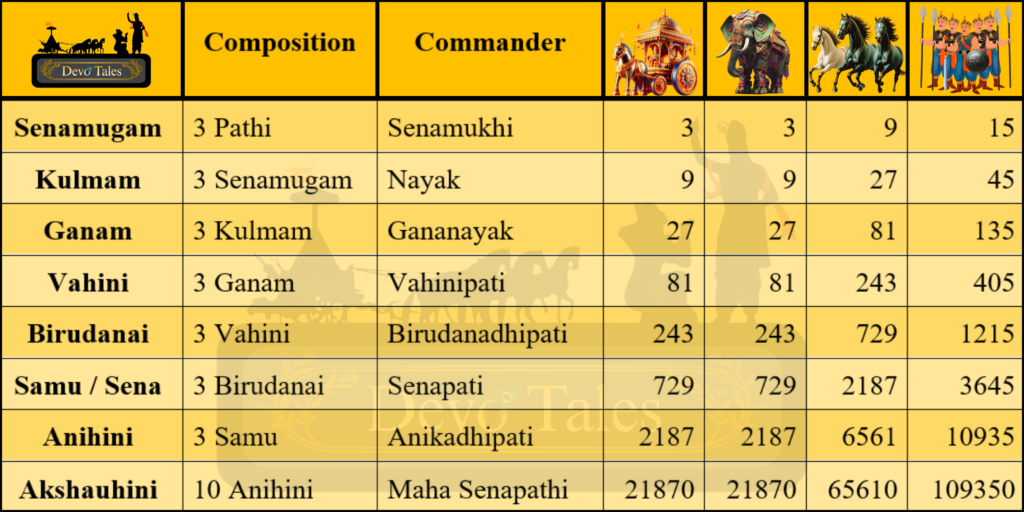What does it take to build an army of monumental scale, one that could shake the very foundations of history?
Ever wondered how ancient Indian texts like Mahabharata describe military formations and strategies? How many Soldiers, Chariots, and Elephants would it take to form a massive army capable of changing the course of a war?
What exactly is Akshauhini? What does it mean to have under one banner? And how does this colossal force compare to the smaller, strategically organized units?
As you dive deeper into the structure of these ancient armies, you’ll discover how each formation builds on the other, leading to the awe-inspiring Akshauhini, the ultimate military force in the Ancient Indian Wars. Ready to explore the scale of ancient warfare and the power of Akshauhini? Keep reading to uncover the secrets behind this powerful concept!
The Building Blocks of an Ancient Army
‘How much is Akshauhini?’ In the eightyth verse of the first breath of Mahabharata Adiparvam, Nannaya describes the appearance of Akshauhini as-
సీ॥ వరరథ మొక్కండు వారణ మొక్కండు
తురగముల్ మూఁడు కాల్వురును నేవు
రను సంఖ్య గలయది యగుఁబత్తి;
యది త్రిగుణంబైన సేనాముఖంబు;
దీని త్రిగుణంబు గుల్మంబు; దీని మమ్మడుగగు
గణము; తద్గణము త్రిగుణితమైన
వాహినియగు; దాని వడి మూఁట గుణియింపఁ
బృతననాఁబరుగుఁ; దతృతన మూఁట
ఆ॥ గుణితమైనఁజము వగున్; మరి దానిము
మ్మడుఁగనీకినీ సమాఖ్యనొనరు;
నదియుఁబదియడుంగులైన నక్షౌహిణి
యౌనిరంతర ప్రమాను సంఖ్య.

C|| Vararatha Mokkandu Warana Mokkandu
Turagamul Moodu Kalvurunu Nevu
Ranu Sankya Galayadi Yagubatti;
Yadi Trigunambaina Senamukhambu;
Deeni trigunambu Gulmambu; Deeni Mammadugagu
Ganamu; Tadganamu Trigunithamaina
Vaahiniyagu; Daani Vadi Moota Guniyimpa
Bruthanaabarugu; Dathpruthana Moota
A|| Gunithamainajamu Vagun; Mari Daanimu
Mmaduganikini Samaakhyanonaru;
Nadiyubadhiyadungulaina Nakshauhini
Yaunirantara Pramaanu Sankya.
How Smaller Units Build Up to Akshauhini
From Patti to Senamukha: The First Steps
Which is, the sum of 1 chariot, 1 elephant, 3 horses, and 5 soldiers together is called ‘Patti’. The three times of this army is called ‘Senamukha’. That means there are 3 chariots, 3 elephants, 9 horses, and 15 soldiers.
Growing Power: Gulma, Ganamu, and Vahini
Three times of Senamukha is called ‘Gulma’, which consists of 9 chariots, 9 elephants, 27 horses, and 45 soldiers. Three times of Gulman is called ‘Ganamu’, which consists of 27 chariots, 27 elephants, 81 horses, and 135 soldiers. A ‘Vahini’ three times the size of the Gana consists of 81 chariots, 81 elephants, 243 horses, and an army of 405 men.
The Mighty Prutana and Chamu
Three times of the Vahini is called ‘Pritana’. It consists of 243 chariots, 243 elephants, 729 horses, and a 1215-man army. Three times the Prutana called ‘Chamu’, which consists of 729 chariots, 729 elephants, 2187 horses, and an army of 3645 men.
Anikini: A Step Closer to Akshauhini
The Final Form: Akshauhini
‘Anikini’ three times the Chamu. It has 2187 chariots, 2187 elephants, 6561 horses, and 10935 soldiers. Ten times the Anikini is called ‘Akshauhini’. That means ‘Akshauhini’ has an army of 21,870 chariots, 21,870 elephants, 65,610 horses, and 1,09,350 soldiers.

Why Akshauhini Matters in Ancient Warfare?
The concept of Akshauhini highlights the range of ancient warfare and military strategy. By understanding how each formation builds upon the other, we can better appreciate the organization and immense power of ancient Indian armies. This massive military structure reflects not only the might of the forces involved but also the strategic thinking required to manage such vast numbers.


good info maam